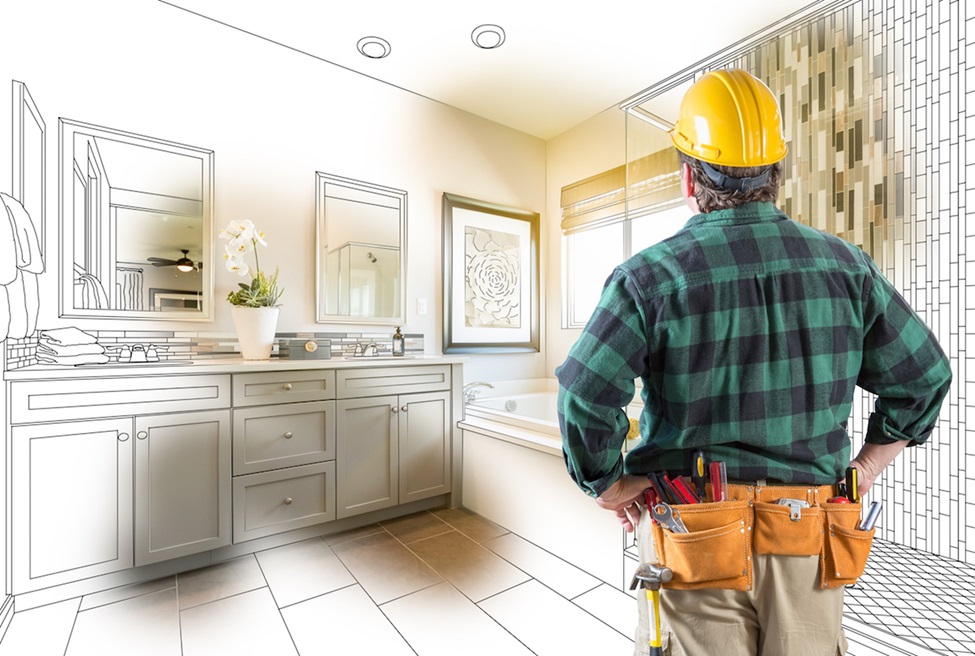There are many reasons why a bathroom might need a remodel. Perhaps the style needs a refresh, the design isn’t functional, or it’s a remodel after a significant repair. While searching for bathroom remodel designers near me on Google will bring tons of links to look at, it doesn’t explain the process of a bathroom remodel or who should do it.
Some homeowners might think they can take on a bathroom remodel project on their own without professional help, but there are drawbacks. This article will give you some helpful information on whether a homeowner, professional designer, or contractor should design a bathroom remodel.
Homeowner vs. Professional
Some folks are handy, DIY types, and taking on a bathroom remodel might seem like an easy task, but it’s what’s underneath that can often cause problems. Problems like faulty wiring, poor ventilation, and incorrect materials can often go unnoticed until the demo process begins. Needing to re-route or replace existing plumbing can be an expensive additional cost that most people can’t do.
A professional designer takes the homeowner’s desired outcome and comes up with a plan. This plan includes time management, budget, and materials. The professional designer will work within the budget set for the project and will provide knowledgeable suggestions on materials to use. They will know if there’s new plumbing to install or new wiring for a new light. They’ll also have a realistic expectation of the project and how it will turn out. It’s easy for a homeowner to see images on a design show but not realize that their space will not support that type of design.
When it’s a do-it-yourself project under time constraints, it may lead to issues. Imagine having a non-functioning bathroom for weeks instead of a weekend. Shortcuts happen, and things can get overlooked. Often, people start a project and realize they can’t complete it, need a professional, and can’t get on someone’s schedule. While many do-it-yourself renovations happen, there are often things that are overlooked or don’t get addressed.
The fun part of any design project is determining what colors, materials, and elements will go into the new bathroom. A professional designer will have the knowledge and expertise on different brands and products that will work well.
Designers find out the homeowner’s tastes and styles, using images and example designs for inspiration. Designers explore what colors are appealing, functional needs that need to be incorporated, elements desired like a walk-in shower versus a bathtub, storage space needs, and future accessibility needs. This ensures that their design will be helpful for the homeowners for years to come.
Design Elements
A designer will bring a few things into the plan that help shape the project into a cohesive form. Design elements are the difference between an aesthetically pleasing bathroom and something that looks a little thrown together. First, the plan uses design elements most homeowners don’t know about, like line, color, value, shape, space, form, and texture.
- Line refers to how things are laid out visually to draw attention to focal points.
- Color is self-explanatory, but value is using color gradients to create depth and the illusion of more space, which is very helpful in small bathrooms.
- Shape applies to both elements in the bathroom and the shape and square footage of the space itself.
- Space and form are dependent on each other, and while one refers to the space itself, the latter refers to how objects take up space and what spaces are created as a result.
- Texture refers to materials used, whether that’s texture on a wall, wood materials, or tile, and how these work within the space. It creates visual interest and tactile experiences that people can feel.
Designers are also great resources for creating designs within any budget, as they stay current with new materials and trends. They’re also great at helping stay clear of the not-so-great trends. They’re going to ensure your bathroom fits within the overall design of the home as well. With the knowledge and expertise to avoid future problems, designers are great at providing alternative ideas.
Designers vs. Contractors
While many design firms work with contractors and builders, the contractor has experience doing the actual work. This gives a real perspective of knowing what it will take to complete a project based on the design. Contractors also know what has worked in the past, what potential problems might come up, and what alternatives have worked well in a design.
Contractors like JMG Contracting are familiar with current building codes and might see if a bathroom might have more significant issues lurking underneath. They’ll notice if there’s not currently good bathroom ventilation, which would need to be fixed. The contractor also knows what it will take to demolish and remove items and how to handle any lurking issues like mold or asbestos. Not addressing these issues appropriately will cost the homeowner money and time and could be hazardous.
The contractor also has experience working with the materials chosen for the design. They have first-hand knowledge of the material’s function and sturdiness. They know how long it will take to install tile versus installing a stalled-in tub or shower. If there are time constraints, the contractor knows how long a project should take based on the materials, demolition, and rebuild needs.
Some contractors also take on designing the bathroom remodel. While not a designer, they do have the experience of replicating a design and completing a remodel. They know the materials and can complete the project, but they won’t have the design expertise to incorporate good design elements. Searching the internet for “bathroom remodel designers near me” will create a long list to choose from, so make sure the company you choose has the experience and expertise for the project.

Recent Comments